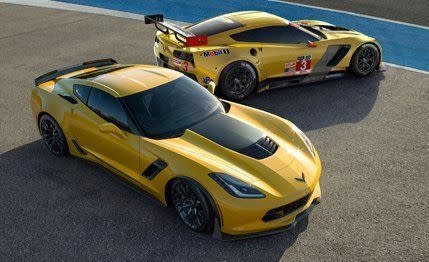2015 Chevrolet Corvette Z06: One Part ZR1, One Part Throwdown for Porsche

To introduce Chevrolet’s third-generation high-performance Corvette Z06, we seriously considered publishing the car’s spec sheet and letting it speak for itself. We haven’t driven the car yet—and likely won’t for another year or so—but given it’s a thinly veiled road-going race car, a cold, efficient, and straight-to-the-point list of its upgrades seems more appropriate than a long-form deep-dive into what sets it apart from the C7 Corvette Stingray on which it is based. Yet while a list might draw a clearly defined line in the sand between the Z06 and its humbler stablemate, it simply couldn’t capture the full wow factor of the thing, the sheer ridiculousness of Chevy’s technological and engineering achievements. So here goes.
When we were first shown the 2015 Corvette Z06 at a behind-the-scenes preview event last month, lead engineer Tadge Juechter minced few words when it came to the relationship between the car and the C7.R racer: The two were, for all intents and purposes, designed concurrently and alongside one another. It only takes a quick glance at the Z06’s widened, lowered, vented, and winged body to understand that. Interestingly, development on the Z06 has only just begun, and it’s really only being shown at the 2014 Detroit auto show because the C7.R makes its race debut later this month; Chevy’s merely removing the bag before the cat can jump out of it. That and Mr. Juechter lamented how difficult high-speed testing is with garbage-bag-like camouflage plastered all over test cars.

No Need to Hold On to Your Hats, Down force Has It Covered
In the past, the Z06 has enjoyed a degree of visual separation from the standard Corvette, but this new one looks like it mainlined a concentrated dose of pure aero. There are no fewer than three (!) aerodynamic packages available, but every one includes a substantial front splitter; an enlarged hood vent that contributes downforce by allowing air flowing through the grille to escape above—rather than underneath—the car; and a hyper-engineered grille mesh that somehow directs more air through the engine compartment than a mesh-less, gaping hole. The most extreme aero kit comes mated to the optional Z07 package, and brings an even deeper front splitter with tall winglets at each corner, deep rocker panel extensions, and a big ducktail spoiler with a manually height-adjustable center portion. That little panel, by the way, is clear to mitigate the wing’s effect on rear visibility.
Other aero tweaks include a pair of brake ducts integrated into the grille, enlarged fender vents, rear brake cooling ducts, and larger air outlets in the rear fascia to help evacuate the increased cooling airflow running over the transmission and differential coolers that live back there. In fact, at the Z06 backgrounder event, Mr. Juechter spent the better part of five minutes discussing the upper rear fender vents alone. Those curious-looking inverted scoops are said to push 50 percent more air into the ducts than the scoopless units fitted to the Stingray. Overall, GM says that the Z06 with the Z07 package whips up (or down?) the most downforce of any production car it’s ever tested—GM-made or otherwise. How much downforce does it make? Chevy’s not saying yet, but assured us that there’s so much of it that the C7.R team for the first time ever didn’t need to add any for the race car; the team instead spent its wind-tunnel time paring back drag.
Vent and spoiler fetishes aside, the Z06’s front and rear fenders are 2.2 and 3.15 inches wider than the Stingray’s in order to fit a wheel and tire package sized the same as that on the outgoing C6 ZR1. The standard setup includes 285/30ZR-19 front and whopping 335/25ZR-20 rear Michelin Pilot Sport tires, while the Z07 package brings near-slick Sport Cup rubber. You’ll notice we haven’t made one mention of the Z06’s “styling”—that’s because it nearly doesn’t matter; race cars are functional beasts, and the Z06 isn’t any different.
Supercharged to Eaton the Competition for Breakfast
In a first for the Z06 breed, the third-gen model’s engine will feature forced induction. A 1.7-liter Eaton R1740 TVS supercharger lives in between the small-block V-8’s vee, and its compactness (including the intercooler) swallows just one additional inch of airspace above the engine. Dubbed LT4, the supercharged 6.2-liter V-8 comes from the same fifth-generation small-block family as the Stingray’s LT1, but gets a thorough overhaul to handle the blower’s might. Chevy fits the LT4 with stronger Rotocast aluminum cylinder heads, titanium intake valves, machined connecting rods, forged aluminum pistons, stainless-steel exhaust headers, and a standard higher-capacity dry-sump oiling setup.
The Stingray’s direct fuel injection carries over to the Z06 and contributes to a high 10.1:1 compression ratio, and that car’s continuously variable valve timing and Active Fuel Management cylinder deactivation functionality also hit the Z06 for the first time. Efficiency is said to be quite high, and we’re tempted to believe the engineers’ hyperbole on this, considering the outgoing C6 Z06 was capable of nearly 30 mpg on the highway in the real world. Official EPA estimates won’t arrive until much later, but that data is far less interesting than the most important powertrain spec of them all: output. Preliminary numbers from the Z06 guys peg the new LT4 at 625 horsepower and 635 lb-ft of torque, figures that knock on the door of the previous-generation ZR1. In fact, the Z06’s torque figure actually betters the ZR1’s by more than 30 lb-ft.

You Might Also Like

 Yahoo Autos
Yahoo Autos 